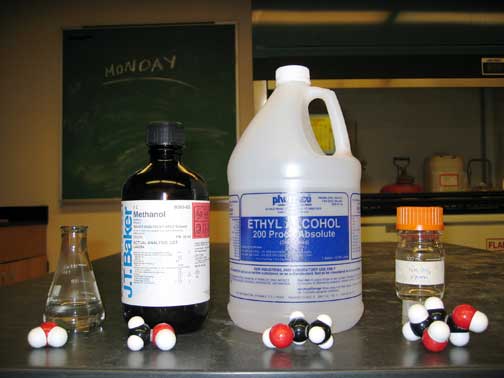Hydrogen bonding forces and the variety of alcohols
 The properties of a series of alcohols are explored.
The properties of a series of alcohols are explored.
Ingredients: water, methanol, ethanol, glycerol
Procedure: A complete recipe follows.
1. Acquire small quantities of water, methanol, ethanol and glycerol.
2. Observe the systems using sight and smell and touch.
Understanding: The compounds known as alcohols exist in a variety of forms. All alcohols have in common the -OH functional group. The electronegative oxygen bonded to the electropositive hydrogen creates a substantial separation of partial charge - the oxygen being negatively charged relative to the positively charged hydrogen. The difference of electronegativity creates a dipole on the -OH functional group.
Since the polar hydrogen of one alcohol can hydrogen bond with the oxygen of another molecule, there is a good deal of intermolecular hydrogen bonding in alcohols. That hydrogen bonding attraction is strong relative to the energy of motion associated with temperature. The ability to hydrogen bond makes the molecules "sticky," lowering the vapor pressure of the alcohols relative to the corresponding hydrocarbon - CH3OH/CH4, C2H5OH/C2H6, C3H5(OH)3/C3H8.
The more alcohol groups that a molecule has, the more hydrogen bonds it might form, and the stickier it will be. So we expect a molecule like glycerol, with three -OH groups, to be "stickier" than water. That is just what is observed - glycerol is far more viscous than water or simple alcohols such as methanol or ethanol, whose viscosity is much like water. Why is that so? Glycerol has more hydrogen bonds formed per molecule!
Hydrogen bonding in alcohols
Question: The boiling points of hydrogenol (water), methanol, and ethanol are 100C (212F), 65C (149F), and 78.5C (173.3F). Explain the trend in boiling points in terms of the relative strengths of intermolecular interactions, including hydrogen bonding interactions.
Hydrogen bonding in water and ammonia
Question:
The boiling points of water and ammonia are 100C (212F) and -33C (-27F).
Explain the trend in boiling points in terms of the relative strengths of intermolecular interactions, including hydrogen bonding interactions.
Consider the structure of the water and ammonia molecules. In a liquid of pure water, how many hydrogen bonds are formed to each molecule on average? In a liquid of pure ammonia, would each ammonia molecule form greater or fewer hydrogen bonds?